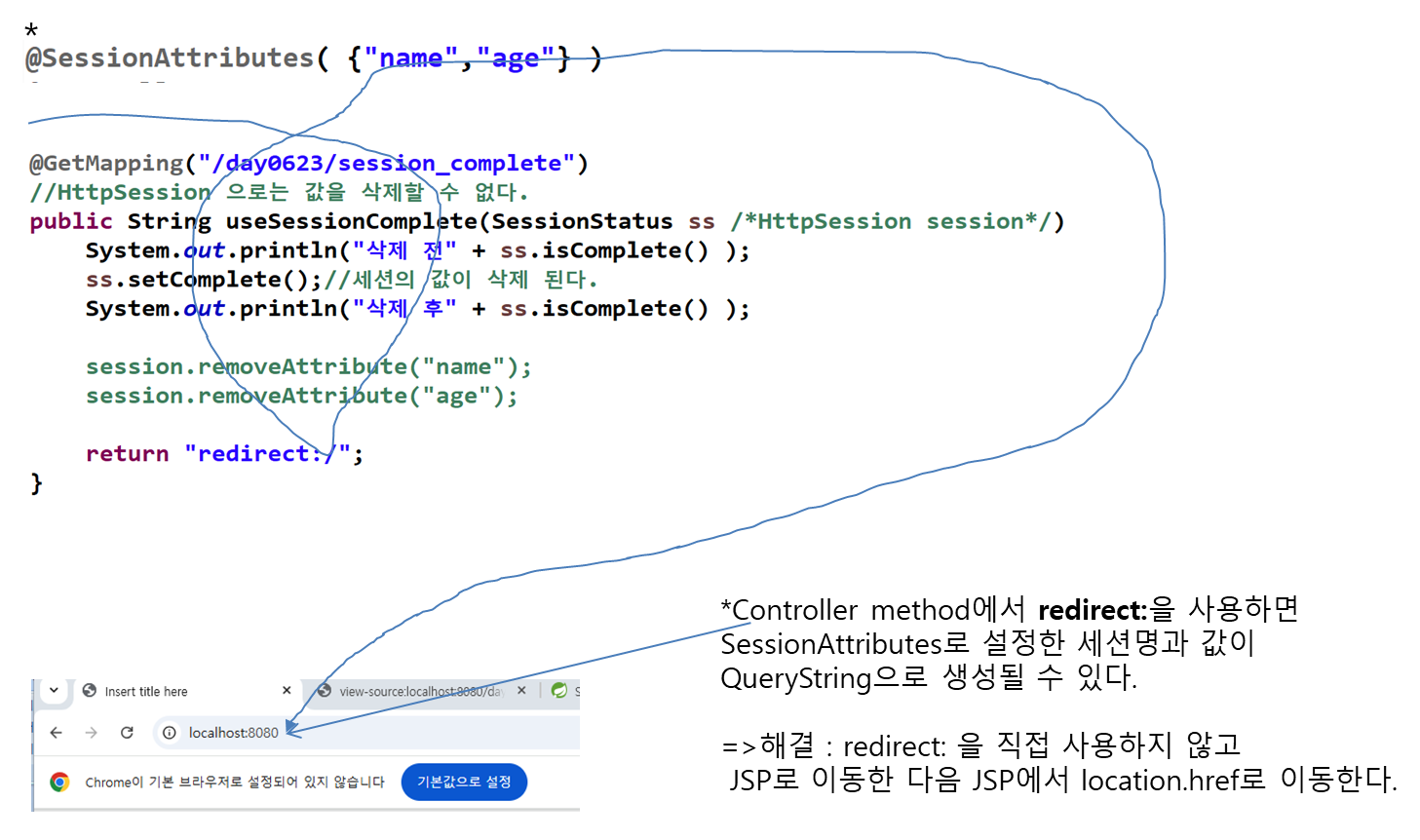*include
- 여러 JSP를 한번에 보여줄 때.
- 중복디자인이나 중복코드를 줄일 목적으로 사용.
<%@ include %> - 중복코드를 처리할 때.( 속도 빠름, 변수, method 공유, 지시자 충돌 발생)
<jsp:include>
<c:import>
-legacy : JSP도 연결 가능, Context로도 연결가능
<jsp:include page=“/경로/JSP명”/>
<jsp:include page=“/Mapping명”/>
-boot : “/경로/JSP명”으로는 연결할 수 없다.( Mapping명으로만 연결 가능 )
<c:import page=“/Mapping명”/>
<jsp:include page=“”/> => Mapping 명은 사용할 수 없고, 상대경로로 직접 연결가능
*관계유지
- 무상태인 웹에서 접속자의 정보를 저장하기 위해 Session, cookie
*session
-접속자의 정보( 접속자 웹 브라우저에 id를 부여)를 서버측 메모리에 저장하는 기술.
-브라우저를 구분하지 않고, 정보를 저장할 수 있다.
-사용할 수 있는 객체 : HttpSession, Model, ModelAndView
*HttpSession사용
1. Controller의 method에서 HttpSession을 매개변수로 선언
@GetMapping(“.. “)
public String method명( HttpSession session){
1.session의 생존시간 설정.
session.setMaxInactiveInterval( 초 );
2.세션 값 할당
session.setAttribute(“이름”, 값 );
3.세션 값 얻기
(Casting)session.getAttribute(“이름”)
4.세션 값 삭제
session.remoteAttribute(“이름”)
5.세션 무효화
session.invalidate();
}
*@SessionAttributes
- Model, ModelAndView에 값을 설정하면 request scope객체에 값이 설정된다.
- class 위 @SessionAttributes( ) 를 사용하면 Model, ModelAndView에 설정된 값이
session과 request에 동시에 할당된다.
사용법)
1.SessionAttributes선언
@Controller
@SessionAttributes(“이름”)
public class TestController{
2. method의 매개변수로 Model 선언
@GetMpping( .. )
public String method( Model model ){
3.SessionAttributes에 설정된 이름과 동일한 이름으로 값 설정
model.addAttribute(“이름”, 값 ); //request scope과 session scope가 동시에 할당된다.
*값 얻기
*Controller 값 얻기
-HttpSession사용.
public String method(HttpSession session){
session.getAttribute(“이름”);
-Model 사용( Spring 5.2버전에서 부터 지원 )
public String method(Model model){
model.getAttribute(“이름”);
*JSP에서 값 얻기
-scriptlet
<% session.getAttribute(“이름”); %>
-EL
${ sessionScope.이름 }
-세션 삭제.
- HttpSession 인터페이스 제공하는 method로는 삭제 할 수 없다.
- org.springframework.web.bind.support.SessionStatus인터페이스를 사용하여 삭제.
사용법)
1.SessionStatus를 매개변수로 하는 methd 생성
public String method( SessionStatus ss ){
ss.setComplete();

*Cookie
- 접속자의 정보를 접속자 HDD에 File로 저장하는 기술.( 문자열로만 저장가능 )
- HttpServletRequest, HttpServletResponse, @CookieValue annotation사용.
*사용법)
쿠키 심기)
1.Controller의 method에서 HttpServletResponse를 선언
@GetMapping( .. )
public String method( HttpServletReponse response){
2.쿠키생성
Cookie cookie=new Cookie(“이름”, ”값”);
3. 생존시간 설정
cookie.setMaxAge( 초 );
4. 쿠키 심기
reponse.addCookie( cookie );
*쿠키읽기
-HttpServletRequest
1. Controller method에서 HttpServletRequest 정의
@GetMapping( .. )
public String method( HttpServletRequest request){
2.쿠키읽기
Cookie[] cookies=request.getCookies();
3. 반복
for( Cookie tempCookie : cookies ){
4. 쿠키 정보얻기
-쿠키명얻기
cookie.getName()
-쿠키의 값 얻기
cookie.getValue()
}
*annotation사용)
method의 매개변수 앞에 선언)
사용법)
1.Controller method에서 매개변수앞에
@CookieValue() 선언
@GetMapping( .. )
public String method(
@CookieValue(value=“이름”,defaultValue=“기본값”) String 변수명){
변수명
*EL에서 쿠키의 값을 얻기
${ cookie.쿠키의이름 } 이름에 해당하는 쿠키가 존재하는지 비교할 때
${ cookie.쿠키의이름.value } 이름에 해당하는 쿠키의 값을 얻을 때.
'Spring' 카테고리의 다른 글
| [Spring] ExceptionHandler, 파일 업로드 (0) | 2025.09.08 |
|---|---|
| [Spring] Controller, web parameter, RequestParam, HttpServletRequest (2) | 2025.09.08 |
| [Spring] 구조, 디렉토리, 설정, tomcat, jakarta, properties (0) | 2025.09.08 |
